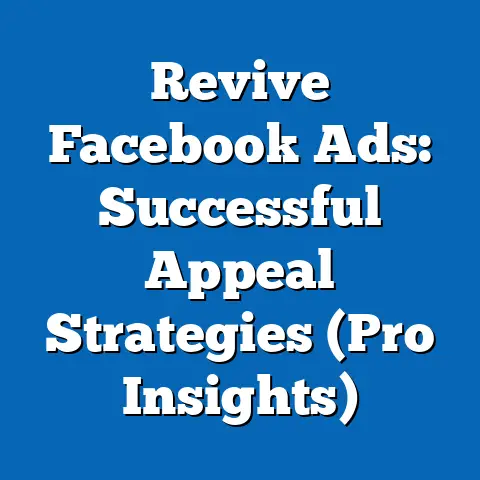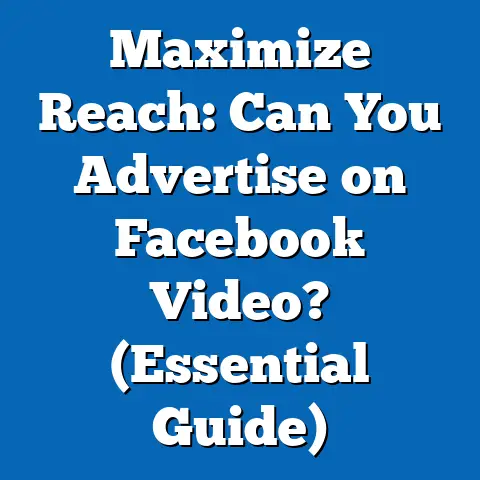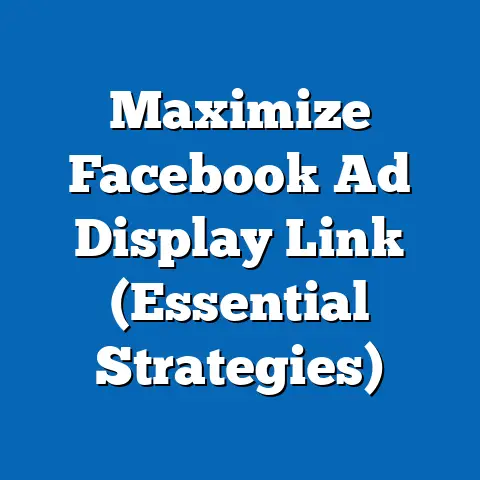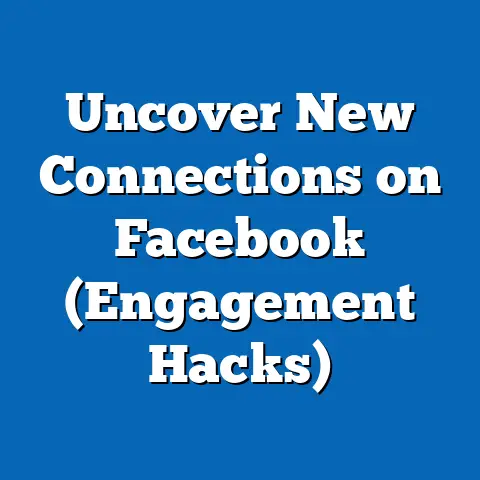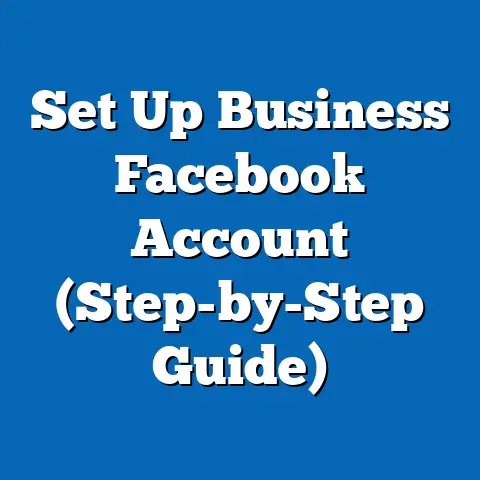Master Facebook Group Growth (Strategic Insights)
We live in a digital age where comfort is a currency. Think about it: we curate our social media feeds, seeking out content that aligns with our values and interests. We join online communities where we feel safe, understood, and valued. This pursuit of comfort is a fundamental human drive, and it’s the key to unlocking explosive growth in your Facebook Group.
Understanding Facebook Groups
Let’s start with the basics. What exactly is a Facebook Group? At its core, it’s a dedicated space on Facebook where people with shared interests can connect, communicate, and collaborate. It’s a digital gathering place, a forum for discussions, and a platform for building relationships.
Think of it like this: if your Facebook Page is your storefront, your Facebook Group is your customer lounge. It’s where you build deeper relationships with your audience, fostering loyalty and advocacy.
There are three main types of Facebook Groups, each offering a different level of privacy and accessibility:
- Public Groups: These are open to everyone on Facebook. Anyone can see the group, its members, and its posts. This is a great option for broad topics where you want to maximize visibility and reach.
- Closed Groups: These require members to request to join. While the group itself is visible, only members can see the posts and discussions within. This offers a greater sense of privacy and encourages more open sharing.
- Secret Groups: These are completely hidden from non-members. Only members can find the group, see who’s in it, and view the content. This provides the highest level of privacy and is ideal for sensitive topics or exclusive communities.
The Significance of Facebook Groups:
Facebook Groups are more than just online forums; they’re powerful tools for building community and brand loyalty. Here’s why they’re so important:
- Community Building: Groups provide a space for people to connect with others who share their interests, passions, or challenges. This fosters a sense of belonging and creates strong bonds between members.
- Brand Loyalty: By creating a group around your brand or product, you can cultivate a loyal following of customers who are passionate about what you offer. This can lead to increased sales, positive word-of-mouth, and valuable feedback.
- Increased Engagement: Groups tend to have higher engagement rates than Facebook Pages. Members are more likely to participate in discussions, share content, and interact with each other.
- Valuable Insights: Groups provide a direct line of communication with your target audience. You can use them to gather feedback, conduct market research, and understand their needs and preferences.
- Organic Reach: While Facebook’s algorithm can limit the reach of Page posts, group posts often have higher visibility because they’re seen as more relevant and engaging.
Takeaway: Understanding the different types of Facebook Groups and their significance is the first step towards creating a thriving online community. Choose the right type of group based on your goals and target audience, and focus on building a space where members feel valued and connected.
The Psychology of Group Growth
Why do people join Facebook Groups? What motivates them to engage and contribute? Understanding the psychology behind group behavior is crucial for creating a community that thrives.
At the heart of it all is the need for belonging. We’re social creatures, wired to connect with others and find our place in a group. Facebook Groups provide a sense of belonging, a feeling of being part of something bigger than ourselves.
Here are some key psychological factors that drive people to join and engage in Facebook Groups:
- Social Proof: People are more likely to join a group if they see that others are already members. This is the principle of social proof in action. If a group has a large and active membership, it signals that it’s a valuable and worthwhile community to join.
- Reciprocity: When people receive something of value, they feel obligated to give back. This is the principle of reciprocity. If you provide valuable content, helpful advice, or a supportive environment in your group, members are more likely to reciprocate by contributing, engaging, and promoting the group to others.
- Emotional Connection: People are drawn to communities that evoke positive emotions. Whether it’s a shared passion, a sense of humor, or a feeling of empathy, emotional connection is a powerful driver of engagement and loyalty.
- Shared Identity: Groups provide a space for people to connect with others who share their identity, whether it’s based on their profession, their hobbies, or their values. This shared identity creates a strong sense of community and belonging.
- Authority and Expertise: People join groups to learn from experts and gain access to valuable information. If you can establish yourself as an authority in your niche, you’ll attract members who are eager to learn from you.
My Experience:
I remember starting a Facebook Group for freelance writers a few years ago. Initially, it was slow going. But once I started consistently sharing valuable tips, answering questions, and creating a supportive environment, the group began to grow exponentially. Members started referring their friends, sharing their successes, and actively participating in discussions. It was amazing to see how a simple act of providing value could create such a strong sense of community.
Takeaway: To effectively grow your Facebook Group, focus on creating a space where members feel a sense of belonging, receive value, and connect emotionally. Understand the psychological factors that drive group behavior and tailor your content and engagement strategies accordingly.
Identifying Your Target Audience
Before you can start building a successful Facebook Group, you need to know who you’re building it for. Identifying your target audience is crucial for creating a community that resonates with the right people.
Think of it like this: you wouldn’t open a vegan restaurant in a town known for its love of barbecue. Similarly, you wouldn’t create a Facebook Group about coding for people who are interested in gardening.
Knowing Your Niche:
The first step is to define your niche. What is the specific topic or interest that your group will focus on? The more specific you are, the easier it will be to attract the right members.
For example, instead of creating a group about “marketing,” you could create a group about “email marketing for e-commerce businesses.” This niche is much more specific and will attract members who are genuinely interested in that topic.
Researching and Understanding Audience Pain Points:
Once you’ve defined your niche, you need to understand the pain points, interests, and preferences of your target audience. What are their biggest challenges? What are they passionate about? What kind of content do they find valuable?
Here are some techniques for researching your target audience:
- Surveys and Polls: Use surveys and polls to gather direct feedback from your target audience. Ask them about their challenges, interests, and preferences.
- Social Media Listening: Monitor social media conversations to see what people are saying about your niche. What are their questions? What are their frustrations?
- Competitor Analysis: Analyze your competitors’ Facebook Groups to see who their members are and what kind of content they’re engaging with.
- Keyword Research: Use keyword research tools to identify the terms that your target audience is using to search for information online.
Creating Member Personas:
Once you’ve gathered enough information, create member personas to represent your ideal group members. A member persona is a fictional representation of your target audience, based on research and data.
Your member persona should include details such as:
- Demographics: Age, gender, location, income, education
- Interests: Hobbies, passions, values
- Pain Points: Challenges, frustrations, goals
- Online Behavior: Social media habits, preferred content formats
Example:
Let’s say you’re creating a Facebook Group for stay-at-home moms. Your member persona might look something like this:
- Name: Sarah
- Age: 32
- Location: Suburban USA
- Occupation: Stay-at-home mom
- Interests: Parenting, healthy eating, fitness, DIY projects
- Pain Points: Feeling isolated, struggling to balance work and family life, lacking time for self-care
- Online Behavior: Spends time on Facebook, Pinterest, and parenting blogs
Takeaway: By understanding your target audience, you can create a Facebook Group that meets their needs and interests. This will attract the right members, foster engagement, and ultimately lead to sustainable growth.
Crafting a Compelling Group Vision
Your Facebook Group needs a purpose, a reason for existing. This purpose is your group vision, and it’s what will attract members and keep them engaged.
Think of your group vision as the North Star that guides your community. It’s the overarching goal that everyone is working towards together.
Why is a Clear Vision Important?
- Attracts the Right Members: A clear vision helps you attract members who are genuinely interested in your topic and aligned with your values.
- Fosters Engagement: A compelling vision gives members a reason to participate and contribute to the community.
- Creates a Sense of Purpose: A clear vision provides members with a sense of purpose and belonging, making them feel like they’re part of something bigger than themselves.
- Drives Growth: A strong vision can attract new members, retain existing members, and encourage them to promote the group to others.
Articulating Your Vision:
Your group vision should be clear, concise, and inspiring. It should clearly communicate the purpose of your group and the value it provides to members.
Here are some tips for articulating your vision:
- Focus on the Benefits: What will members gain by joining your group? What problems will it solve?
- Use Emotional Language: Connect with members on an emotional level by using language that resonates with their feelings and aspirations.
- Be Specific: Avoid vague or generic statements. Be specific about the topic, target audience, and goals of your group.
- Keep it Short and Sweet: Your vision should be easy to understand and remember.
Examples of Successful Group Visions:
- “The Freelance Writer Collective”: A supportive community for freelance writers to connect, collaborate, and grow their careers.
- “The Plant-Based Moms”: A safe space for plant-based moms to share recipes, parenting tips, and support each other on their journey.
- “The Digital Nomad Tribe”: A global community of digital nomads to connect, share travel tips, and inspire each other to live location-independent lives.
My Experience:
When I started my Facebook Group for freelance writers, my vision was simple: to create a supportive community where writers could connect, learn, and grow their careers. I made it clear that the group was a safe space for sharing, asking questions, and celebrating successes. This clear vision attracted writers who were looking for exactly that kind of community, and it helped to foster a culture of collaboration and support.
Takeaway: Crafting a compelling group vision is essential for attracting the right members, fostering engagement, and driving growth. Make sure your vision is clear, concise, and inspiring, and that it resonates with your target audience.
Creating Engaging Content
Content is the lifeblood of any Facebook Group. It’s what attracts members, keeps them engaged, and encourages them to participate in the community.
But not all content is created equal. To truly engage your members, you need to create content that is valuable, relevant, and interactive.
Various Content Types:
Here are some content types that are proven to encourage interaction in Facebook Groups:
- Questions: Asking questions is one of the easiest ways to spark conversation and get members to share their thoughts and experiences.
- Polls: Polls are a fun and engaging way to gather feedback and get members to voice their opinions.
- Live Videos: Live videos are a great way to connect with your members in real-time, answer their questions, and share valuable insights.
- Behind-the-Scenes Content: Share glimpses into your business, your life, or your creative process to build a connection with your members.
- Success Stories: Highlight the successes of your members to inspire others and showcase the value of your community.
- Challenges and Contests: Challenges and contests are a fun way to get members involved and reward them for their participation.
- Resource Sharing: Share valuable resources, such as articles, templates, or tools, to help your members achieve their goals.
- Memes and GIFs: Use memes and GIFs to add humor and personality to your group and lighten the mood.
Consistency and Variety:
Consistency is key when it comes to content. You need to post regularly to keep your members engaged and remind them of the value of your group.
But consistency doesn’t mean posting the same type of content over and over again. You need to mix things up and offer a variety of content to keep your members interested.
User-Generated Content:
One of the best ways to create engaging content is to encourage your members to share their own experiences, insights, and creations. User-generated content (UGC) not only saves you time and effort, but it also builds a stronger sense of community and encourages members to participate.
Here are some ways to encourage UGC:
- Ask Members to Share Their Successes: Celebrate member achievements and encourage them to share their stories with the group.
- Run a Weekly “Share Your Work” Thread: Create a dedicated thread where members can share their latest projects, creations, or blog posts.
- Host a Photo or Video Contest: Encourage members to submit photos or videos related to your niche and reward the best entries.
- Ask Members to Answer Questions: Instead of always answering questions yourself, encourage other members to chime in and share their expertise.
My Experience:
In my freelance writing group, I started a weekly “Share Your Wins” thread where members could share their recent successes. It was amazing to see how much this simple thread boosted morale and encouraged members to celebrate each other’s achievements. It also inspired others to keep pushing themselves and striving for success.
Takeaway: Creating engaging content is essential for attracting members, fostering engagement, and building a thriving Facebook Group. Offer a variety of content types, post consistently, and encourage user-generated content to create a community that is active, vibrant, and valuable.
Strategic Group Promotion
You’ve created a fantastic Facebook Group with a clear vision and engaging content. Now, how do you get people to join? Strategic promotion is key to expanding your reach and attracting the right members.
Organic Promotion:
Organic promotion involves using free methods to spread the word about your group. Here are some effective organic strategies:
- Leverage Your Existing Facebook Profile: Share your group on your personal profile, inviting friends and family to join.
- Promote on Your Facebook Page: Regularly promote your group on your Facebook Page, highlighting its benefits and value.
- Cross-Promotion with Other Groups: Collaborate with other group admins to cross-promote each other’s communities.
- Engage in Relevant Discussions: Participate in discussions in other Facebook Groups and mention your group when relevant.
- Optimize Your Group for Search: Use relevant keywords in your group name, description, and tags to improve its visibility in search results.
Paid Advertising:
Paid advertising can be a powerful way to reach a wider audience and accelerate your group growth. Here are some tips for using Facebook Ads to promote your group:
- Target Your Ideal Members: Use Facebook’s targeting options to reach people who are most likely to be interested in your group.
- Create Compelling Ad Copy: Highlight the benefits of joining your group and use a clear call to action.
- Use Eye-Catching Visuals: Use images or videos that are visually appealing and relevant to your group.
- Track Your Results: Monitor your ad performance to see what’s working and what’s not, and adjust your strategy accordingly.
Collaboration with Influencers:
Partnering with influencers in your niche can be a great way to reach a new audience and build credibility for your group.
Here are some ways to collaborate with influencers:
- Invite Influencers to Join Your Group: Ask influencers to join your group and participate in discussions.
- Feature Influencers in Your Content: Interview influencers, share their content, or invite them to host a live video in your group.
- Run a Joint Giveaway: Partner with an influencer to run a giveaway that promotes both your group and their brand.
Leveraging Existing Channels:
Don’t forget to leverage your existing social media channels and email lists to promote your group.
Here are some ways to do this:
- Share Your Group on Other Social Media Platforms: Promote your group on Twitter, Instagram, LinkedIn, and other platforms.
- Include a Link to Your Group in Your Email Signature: Make it easy for people to join your group by including a link in your email signature.
- Send an Email to Your List: Announce your group to your email list and invite them to join.
My Experience:
When I launched my freelance writing group, I ran a Facebook Ad campaign targeting freelance writers in specific locations. I used compelling ad copy that highlighted the benefits of joining the group, such as networking opportunities, access to valuable resources, and a supportive community. The campaign was a huge success, and it helped me to quickly grow the group to a significant size.
Takeaway: Strategic promotion is essential for expanding your reach and attracting the right members to your Facebook Group. Use a combination of organic and paid strategies, collaborate with influencers, and leverage your existing channels to spread the word about your community.
Building a Community Culture
A thriving Facebook Group is more than just a collection of members; it’s a community with its own unique culture. Building a positive and supportive community culture is essential for fostering engagement, retaining members, and driving long-term growth.
Group Rules and Guidelines:
Establishing clear group rules and guidelines is the first step towards building a positive community culture. Your rules should outline what is and isn’t acceptable behavior in the group, and they should be enforced consistently.
Here are some common group rules:
- Be Respectful: Treat all members with respect, even if you disagree with their opinions.
- No Spam or Self-Promotion: Avoid posting spam or promoting your own products or services without permission.
- Stay on Topic: Keep discussions relevant to the group’s topic.
- No Hate Speech or Discrimination: Any form of hate speech or discrimination will not be tolerated.
- Respect Privacy: Do not share personal information about other members without their consent.
Moderation and Active Participation:
Moderation is key to enforcing your group rules and maintaining a positive community culture. As an admin or moderator, you should actively monitor the group, remove inappropriate content, and address any conflicts that arise.
But moderation is not just about policing the group; it’s also about actively participating in discussions, answering questions, and providing support to members. The more you engage with your community, the more likely they are to engage with each other.
Recognizing and Rewarding Contributions:
Recognizing and rewarding member contributions is a great way to foster loyalty and encourage participation.
Here are some ways to recognize and reward contributions:
- Feature Member Content: Highlight member posts that are particularly valuable or engaging.
- Give Shout-Outs: Publicly acknowledge members who are actively contributing to the community.
- Offer Exclusive Perks: Provide exclusive perks, such as discounts or early access to content, to your most active members.
- Create a “Member of the Month” Program: Recognize one outstanding member each month for their contributions to the group.
My Experience:
In my freelance writing group, I created a “Featured Member” program where I highlighted one member each week who had made a significant contribution to the community. This not only recognized their efforts, but it also inspired other members to get involved and contribute.
Takeaway: Building a positive community culture is essential for fostering engagement, retaining members, and driving long-term growth. Establish clear group rules, actively moderate the community, and recognize and reward member contributions to create a space where everyone feels valued and supported.
Analyzing Group Performance
You’ve built a thriving Facebook Group, but how do you know if it’s actually achieving your goals? Analyzing your group performance is crucial for understanding what’s working, what’s not, and how you can improve your strategy.
Tools and Metrics:
Facebook provides a number of built-in tools and metrics that you can use to track your group performance. Here are some key metrics to monitor:
- Membership Growth: Track the number of new members joining your group over time.
- Engagement Rate: Measure the percentage of members who are actively engaging with your content (e.g., liking, commenting, sharing).
- Post Reach: See how many people are seeing your posts.
- Top Posts: Identify your most popular posts and analyze what made them successful.
- Member Demographics: Understand the demographics of your members (e.g., age, gender, location).
- Active Days/Times: See when your members are most active in the group.
Interpreting Data:
Once you’ve gathered data on your group performance, you need to interpret it and use it to make informed decisions.
Here are some questions to ask yourself:
- Is my group growing at a healthy rate? If not, what can I do to attract more members?
- Are my members engaged with my content? If not, what can I do to create more engaging content?
- What types of content are performing best? Focus on creating more of that type of content.
- When are my members most active? Post content during those times to maximize reach and engagement.
Adapting and Evolving Your Strategy:
Analyzing your group performance is not a one-time thing; it’s an ongoing process. You should regularly monitor your metrics, interpret the data, and adapt your strategy accordingly.
The Facebook landscape is constantly evolving, so it’s important to stay up-to-date on the latest trends and best practices. Be willing to experiment with new strategies and tactics, and don’t be afraid to adjust your approach based on what’s working and what’s not.
My Experience:
I used to post content in my freelance writing group at random times throughout the day. But after analyzing my group performance, I discovered that my members were most active in the evenings. So, I started scheduling my posts to go out during those peak hours, and I saw a significant increase in reach and engagement.
Takeaway: Analyzing your group performance is essential for understanding what’s working, what’s not, and how you can improve your strategy. Monitor your metrics, interpret the data, and adapt your approach to stay ahead of the curve and maximize your group’s success.
Success Stories and Case Studies
Let’s take a look at some real-life examples of Facebook Groups that have successfully mastered growth. By analyzing their strategies and learning from their experiences, you can gain valuable insights and inspiration for your own group.
Case Study 1: The Curly Girl Method Group
This group is dedicated to helping women with curly hair embrace their natural texture and find the products and techniques that work best for them.
- Key Strategies:
- Niche Focus: The group is highly focused on a specific niche (curly hair), which attracts members who are genuinely interested in the topic.
- Community Support: The group provides a supportive and welcoming environment where members can share their experiences, ask questions, and get advice.
- Expert Advice: The group features expert advice from hairstylists and other professionals in the curly hair industry.
- Lessons Learned:
- Niche down to attract a highly engaged audience.
- Foster a supportive community where members feel comfortable sharing and asking questions.
- Provide access to expert advice to build credibility and provide value.
- Niche Focus: The group is highly focused on a specific niche (curly hair), which attracts members who are genuinely interested in the topic.
- Community Support: The group provides a supportive and welcoming environment where members can share their experiences, ask questions, and get advice.
- Expert Advice: The group features expert advice from hairstylists and other professionals in the curly hair industry.
- Niche down to attract a highly engaged audience.
- Foster a supportive community where members feel comfortable sharing and asking questions.
- Provide access to expert advice to build credibility and provide value.
Case Study 2: The Minimalists Group
This group is for people who are interested in living a more minimalist lifestyle.
- Key Strategies:
- Clear Vision: The group has a clear vision of helping members declutter their lives and focus on what’s truly important.
- Engaging Content: The group features engaging content, such as articles, videos, and discussions, that inspire members to live more intentionally.
- Challenges and Events: The group hosts challenges and events that encourage members to take action and make progress towards their minimalist goals.
- Lessons Learned:
- Have a clear vision that resonates with your target audience.
- Provide engaging content that inspires and motivates members.
- Host challenges and events to encourage action and build community.
- Clear Vision: The group has a clear vision of helping members declutter their lives and focus on what’s truly important.
- Engaging Content: The group features engaging content, such as articles, videos, and discussions, that inspire members to live more intentionally.
- Challenges and Events: The group hosts challenges and events that encourage members to take action and make progress towards their minimalist goals.
- Have a clear vision that resonates with your target audience.
- Provide engaging content that inspires and motivates members.
- Host challenges and events to encourage action and build community.
Case Study 3: The Baking for Beginners Group
This group is for people who are new to baking and want to learn the basics.
- Key Strategies:
- Beginner-Friendly: The group is designed specifically for beginners, which makes it less intimidating for newcomers.
- Step-by-Step Instructions: The group provides step-by-step instructions and tutorials that make it easy for beginners to learn new skills.
- Positive Reinforcement: The group celebrates member successes and provides positive reinforcement to encourage them to keep learning.
- Lessons Learned:
- Cater to a specific skill level to attract the right members.
- Provide clear and easy-to-follow instructions.
- Offer positive reinforcement to encourage participation and build confidence.
- Beginner-Friendly: The group is designed specifically for beginners, which makes it less intimidating for newcomers.
- Step-by-Step Instructions: The group provides step-by-step instructions and tutorials that make it easy for beginners to learn new skills.
- Positive Reinforcement: The group celebrates member successes and provides positive reinforcement to encourage them to keep learning.
- Cater to a specific skill level to attract the right members.
- Provide clear and easy-to-follow instructions.
- Offer positive reinforcement to encourage participation and build confidence.
My Experience:
I’ve learned so much from observing successful Facebook Groups in various niches. One of the biggest takeaways for me has been the importance of creating a strong community culture. Groups that prioritize building relationships and fostering a sense of belonging tend to be the most engaged and successful.
Takeaway: Studying successful Facebook Groups can provide valuable insights and inspiration for your own community. Pay attention to their strategies, their content, and their community culture, and adapt their best practices to your own group.
Conclusion
Mastering Facebook Group growth is not about tricks or hacks; it’s about building a genuine community where people feel comfortable, valued, and connected. As I’ve shared throughout this article, comfort is the key. When members feel safe and understood, they’re more likely to engage, contribute, and promote your group to others.
Here’s a recap of the key insights we’ve covered:
- Understand the Different Types of Facebook Groups: Choose the right type of group based on your goals and target audience.
- Know Your Audience: Research their pain points, interests, and preferences to create a community that meets their needs.
- Craft a Compelling Vision: Articulate a clear and inspiring vision that resonates with your target audience.
- Create Engaging Content: Offer a variety of content types, post consistently, and encourage user-generated content.
- Promote Your Group Strategically: Use a combination of organic and paid strategies to reach a wider audience.
- Build a Positive Community Culture: Establish clear rules, actively moderate the community, and recognize member contributions.
- Analyze Your Group Performance: Monitor your metrics, interpret the data, and adapt your strategy accordingly.
- Learn from Success Stories: Study successful Facebook Groups and adapt their best practices to your own community.
Now it’s time to put these strategies into action. Take what you’ve learned in this article and start implementing it in your own Facebook Group. Remember, building a thriving community takes time, effort, and dedication. But with a clear vision, a strategic approach, and a commitment to creating a positive and supportive environment, you can master the art of Facebook Group growth and build a community that makes a real difference in the lives of its members.
So, go out there, create your community, and make a positive impact on the world!

